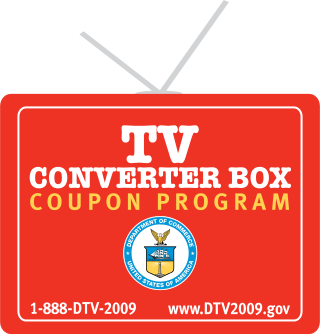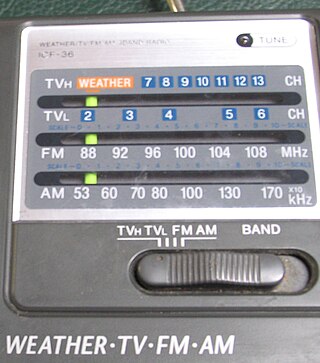
Analog television is the original television technology that uses analog signals to transmit video and audio. In an analog television broadcast, the brightness, colors and sound are represented by amplitude, phase and frequency of an analog signal.

Digital television (DTV) is the transmission of television signals using digital encoding, in contrast to the earlier analog television technology which used analog signals. At the time of its development it was considered an innovative advancement and represented the first significant evolution in television technology since color television in the 1950s. Modern digital television is transmitted in high-definition television (HDTV) with greater resolution than analog TV. It typically uses a widescreen aspect ratio in contrast to the narrower format (4:3) of analog TV. It makes more economical use of scarce radio spectrum space; it can transmit up to seven channels in the same bandwidth as a single analog channel, and provides many new features that analog television cannot. A transition from analog to digital broadcasting began around 2000. Different digital television broadcasting standards have been adopted in different parts of the world; below are the more widely used standards:

NTSC is the first American standard for analog television, published in 1941. In 1961, it was assigned the designation System M. It is also known as EIA standard 170.
8VSB is the modulation method used for broadcast in the ATSC digital television standard. ATSC and 8VSB modulation is used primarily in North America; in contrast, the DVB-T standard uses COFDM.

Advanced Television Systems Committee (ATSC) standards are an International set of standards for broadcast and digital television transmission over terrestrial, cable and satellite networks. It is largely a replacement for the analog NTSC standard and, like that standard, is used mostly in the United States, Mexico, Canada, South Korea and Trinidad & Tobago. Several former NTSC users, such as Japan, have not used ATSC during their digital television transition, because they adopted other systems such as ISDB developed by Japan, and DVB developed in Europe, for example.

The All-Channel Receiver Act of 1962 (ACRA), commonly known as the All-Channels Act, was passed by the United States Congress in 1961, to allow the Federal Communications Commission to require that all television set manufacturers must include UHF tuners, so that new UHF-band TV stations could be received by the public. This was a problem at the time since most affiliated stations of the Big Three television networks were well-established on VHF, while many local-only stations on UHF were struggling for survival.

A tuner is a subsystem that receives radio frequency (RF) transmissions, such as FM broadcasting, and converts the selected carrier frequency and its associated bandwidth into a fixed frequency that is suitable for further processing, usually because a lower frequency is used on the output. Broadcast FM/AM transmissions usually feed this intermediate frequency (IF) directly into a demodulator that converts the radio signal into audio-frequency signals that can be fed into an amplifier to drive a loudspeaker.
A digital channel election was the process by which television stations in the United States chose which physical radio-frequency TV channel they would permanently use after the analog shutdown in 2009. The process was managed and mandated by the Federal Communications Commission for all full-power TV stations. Low-powered television (LPTV) stations are going through a somewhat different process, and are also allowed to flash-cut to digital.

A digital television adapter (DTA), commonly known as a converter box or decoder box, is a television tuner that receives a digital television (DTV) transmission, and converts the digital signal into an analog signal that can be received and displayed on an analog television set. Some also have an HDMI output since some TVs with HDMI do not have a digital tuner. The input digital signal may be over-the-air terrestrial television signals received by a television antenna, or signals from a digital cable system. It normally does not refer to satellite TV, which has always required a set-top box either to operate the big satellite dish, or to be the integrated receiver/decoder (IRD) in the case of direct-broadcast satellites (DBS).

A coupon-eligible converter box (CECB) was a digital television adapter that met eligibility specifications for subsidy "coupons" from the United States government. The subsidy program was enacted to provide terrestrial television viewers with an affordable way to continue receiving free digital terrestrial television services after the nation's television service transitioned to digital transmission and analog transmissions ceased. The specification was developed by the National Telecommunications and Information Administration (NTIA), with input from the broadcast and consumer electronics industries as well as public interest groups.

A DTV receiver is a set-top box that permits the reception of digital television. Its components are very similar to a desktop PC. The DTV receiver is a vital link in the chain of television system. The goal of a broadcasting system is to concentrate the hardware requirements at the source to simplify the receivers and makes it as inexpensive as possible.
Digital television in the United States is available via digital terrestrial television (DTT), digital cable, satellite television, and IPTV providers.

A cable converter box or television converter box is an electronic tuning device that transposes/converts channels from a cable television service to an analog RF signal on a single channel, usually VHF channel 3 or 4, or to a different output for digital televisions such as HDMI.
Analog passthrough is a feature found on some digital-to-analog television converter boxes. Boxes without the analog passthrough feature only allow older, analog-only TVs to view digital TV. Those with analog passthrough allow both digital and analog television to be viewed on older TVs.
The digital transition in the United States was the switchover from analog to exclusively digital broadcasting of terrestrial television programming. According to David Rehr, then president and CEO of the National Association of Broadcasters, this transition represented "the most significant advancement of television technology since color TV was introduced." For full-power TV stations, the transition went into effect on June 12, 2009, with stations ending regular programming on their analog signals no later than 11:59 p.m. local time that day.
The Community Broadcasters Association (CBA) was a trade organization representing low-power broadcasting interests, including LPTV and Class A television stations, in the United States of America. It ceased operations in 2009.
In North American digital terrestrial television broadcasting, a distributed transmission system is a form of single-frequency network in which a single broadcast signal is fed via microwave, landline, or communications satellite to multiple synchronised terrestrial radio transmitter sites. The signal is then simultaneously broadcast on the same frequency in different overlapping portions of the same coverage area, effectively combining many small transmitters to generate a broadcast area rivalling that of one large transmitter or to fill gaps in coverage due to terrain or localised obstacles.
This is a list of low-power television stations (LPTV) in the United States, transmitting on VHF channel 6, which also operate as radio stations capable of being picked up by many standard FM receivers. These stations are colloquially known as "Franken FMs", a reference to Frankenstein's monster, because TV stations functioning as radio stations had not been envisioned by the Federal Communications Commission (FCC). The FCC commonly refers to these stations as "FM6" operations. All of these FM transmissions are authorized for operation on a center frequency of 87.75 MHz.

TV radio, TV band radio, and TV audio radio are common names for a type of radio receiver that can play the audio portion of a TV channel. The actual name of the device may comprise a list of all frequency bands the device can receive, one or two of which includes the TV channel bands.

UHF television broadcasting is the use of ultra high frequency (UHF) radio for over-the-air transmission of television signals. UHF frequencies are used for both analog and digital television broadcasts. UHF channels are typically given higher channel numbers, like the US arrangement with VHF channels (initially) 1 to 13, and UHF channels (initially) numbered 14 to 83. Compared with an equivalent VHF television transmitter, to cover the same geographic area with a UHF transmitter requires a higher effective radiated power, implying a more powerful transmitter or a more complex antenna. However, the additional channels allow more broadcasters in a given region without causing objectionable mutual interference.












